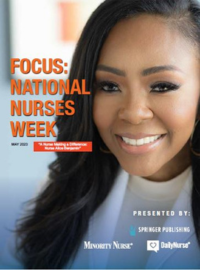Trying to Breathe Easy
What is social capital and can social capital play a role in better asthma outcomes in children residing in homeless shelters? These were some of the questions that guided a research proposal for the Research Infrastructure in Minority Institutions—Career Opportunities in Research (RIMI-COR) grant at Mercy College. Funding for this study was made possible in part by a grant from the National Institute on Minority Health and Health Disparities.
A pilot study was undertaken from October 2008 through August 2009 to quantify if social capital structures existed in three homeless shelters in New York City and if shelter residents were aware of these structures, and to examine parental perceptions about their child’s asthma (controlled/uncontrolled and mild/moderate/severe) and clinician concordance of parental assessment.
Five Mercy College nursing students assisted the researcher in this study with literature reviews and data collection. Engaging nursing students in research is an important venue because it gives students opportunities to examine health issues that are outside of their purview. Further, the students participating in data collection learned about social contributors to health disparities.
Additionally, this research is also being undertaken at a transitional homeless shelter in San Francisco, California. A medical student from University of California, San Francisco has assisted with data collection (anticipated completion in August 2012). To date, 13 parents have participated in the study.
Putnam defined social capital as social relationships (interpersonal trust, norms of reciprocity, and civic responsibilities) within communities that act as resources for individuals and facilitate collective action for mutual benefit.1 Social capital structures are systems of networks, norms, and trust relationships, which allow communities to address common problems.2
Social capital and health linkages are paltry, but research has shown that higher levels of social capital lead to better health outcomes and lower mortality rates in adults and children.3 Asthma prevalence in the United States is about 8.9% and affects more than 6.8 million children and adolescents.4 Asthma is overrepresented in children living in poverty and asthma rates in homeless children are six times the national average.5,6
Social capital in homeless shelters refers to those structures that facilitate social relationships, interpersonal trust, social engagement, and civic responsibilities. Social capital resources were viewed as case managers, onsite medical clinics, educational programs, and shelter governance meetings.
If we consider that homeless shelters might function as a community, structural features that can stimulate social capital may improve childhood asthma outcomes. Further, engaging homeless families in the tenets of social capital may be the means to facilitate participation in community events when they become permanently housed. Active community participation is essential to bring about the social and physical resources necessary to reduce the detrimental environmental exposures in lower income communities.
Self-rated health and psychological well-being are higher in individuals who reported increased levels of community trust and less political participation such as voting has been associated with poorer self-rated health.7,8,9 Therefore, if homeless shelters provided onsite medical clinics (a social capital resource) would parents rate their children’s asthma as controlled? Encouraging patterns of social engagement with the onsite medical clinic would reduce visits to the emergency room. Further, understanding how social capital interacts with the homeless shelter environments (physical and social) could influence how parents understand or perceive their child’s asthma.
The three shelters were identified by an organization that provides onsite medical services at family shelters. Nineteen parents who had asthmatic children (aged six or older) completed a questionnaire adapted from the American Academy of Pediatrics (v. 3.1; 6/02). The questions covered the child’s health, child’s activities, information about the parent, and information about the shelter. The questionnaire was also translated into Spanish. The questionnaire was read to most of the parents because literacy was a problem.
The researcher, a family nurse practitioner, used the National Heart and Lung Institute’s Guidelines for the Diagnosis and Management of Asthma to determine if the child’s asthma was controlled or uncontrolled and the severity of the child’s asthma (mild, moderate, and severe). The social capital indicators examined were voting patterns and if the shelter had case managers, onsite medical clinic, educational programs, town hall meetings, and governance meetings for the shelter residents.
Self-reported demographic characteristics of the study sample can be found in the images accompanying this article. The questionnaire asked about gender, socioeconomic status indicators (income, education, and occupation), insurance information, and if this was their first time living in a homeless shelter.
All of the homeless shelters had case managers, onsite medical clinics, education programs such as GED preparation, town hall meetings, and shelter governance meetings. Respondents were asked if they were aware of these social capital structures and if they voted and if not, their reasons. About 58% of respondents indicated their awareness of town hall meetings; 21% indicated they did not know about these meetings, and 21% answered don’t know. Most parents knew their case managers (90%), 5% indicated they did not know them, and 5% answered don’t know. Most parents knew about the onsite medical clinic (95%) and only 5% responded don’t know. Parents used the medical clinic (32%) for asthma problems and 58% chose not to use the onsite clinic because the clinic was closed; they brought their child to the ER or to their private clinician. Few parents were aware of educational programs (16%); 47% specified no and 37% responded don’t know. A minority of parents were aware of shelter governance meetings (37%); 26% were unaware of these meetings and 37% answered don’t know. Most respondents voted (68%) whereas 32% indicated they did not vote. Reasons given for not voting were (1) not registered, (2) did not know where to vote, (3) did not know about a particular election, and (4) did not want to vote.

Parents were asked to subjectively assess if their child’s asthma was controlled or uncontrolled and to rate if their child’s asthma was mild, moderate, or severe. Mild was defined as not too bad, moderate was considered bad, and severe was considered very bad. Assessment of the child’s asthma by the researcher was based on the parent’s answers about medication usage and types of medication the child had been prescribed. Cross-tabulations were performed to examine clinician and parental concordance of asthma perceptions and asthma severity.
The clinician and the parent agreed at a 91% rate that the child’s asthma was controlled and 25% that the child’s asthma was uncontrolled. The clinician-parent concordance for asthma severity was 70% for mild, 14.3% for moderate, and 50% for severe.
This small-scale exploratory study was able to quantify that social capital structures existed in family homeless shelters in New York City; however, respondents were more aware of some of these structures than others. Additionally, this study investigated parental perceptions about their child’s asthma because data suggested that social capital may be a determinant in self-rated health and thus could potentially be extended to perceptions about a child’s health status. Further, if the parent sought treatment at the onsite medical clinic, did the parent gain a better understanding of asthma triggers and medications leading to decreased visits to an emergency room?
Theoretically, social capital can broadly examine the structural inequalities that contribute to health disparities. Additionally, social capital may increase our understanding of the associations of homelessness and health problems because linking social capital and health may enable homeless shelters to address cultural norms that are detrimental to health, ensure the adequate provision of health care, and collectively build infrastructures that are conducive to better health outcomes.
References
- R.D. Putnam, “Bowling alone: America’s declining social capital,” Journal of Democracy 6 (1995):65-78.
- P.M. Pronyk, et al., “Is social capital associated with HIV risk in rural South Africa?” Social Science & Medicine 66(2008): 1999-2010.
- I. Kawachi, B.P. Kennedy, and R. Glass, “Social capital and self-rated health: A contextual analysis,” American Journal of Public Health 89 (1999): 1187-1193.
- E. Forno and J.C. Celedon, “Asthma and ethnic minorities: Socioeconomic status and beyond,” Current Opinion in Allergy and Clinical Immunology 9 (2009): 154-160.
- J.J. Cutuli, J.E. Herbers, M. Rinaldi, A.S. Masten, and C.N. Oberg, “Asthma and behavior in homeless 4- to 7-year-olds,” Pediatrics 125 (2010): 145-151.
- D. McLean, S. Bowen, K. Drezner, A. Rowe, P. Sherman, S. Schroeder, K. Redlener, and I. Redlener, “Asthma among homeless children: Undercounting and undertreating the underserved,” Archives of Pediatric and Adolescent Medicine 158: (2004):244-249.
- T. Nieminen, T. Martelin, S. Koskinen, H. Aro, E. Alanen, and M.T. Hyyppa, “Social capital as a determinant of self-rated health and psychological well-being,” International Journal of Public Health (2010): doi: 10.1007/s00038-010-0138-3.
- S.V. Subramanian, D.J. Kim, I. Kawachi, “Social trust and self-rated health in US communities: A multilevel analysis,” Journal of Urban Health 79(2002): S21-S34.
- T.A. Blakely, B.P. Kennedy, and I. Kawachi, “Socioeconomic inequality in voting participation and self-rated health,” American Journal of Public Health, 91(2001): 99-104.


